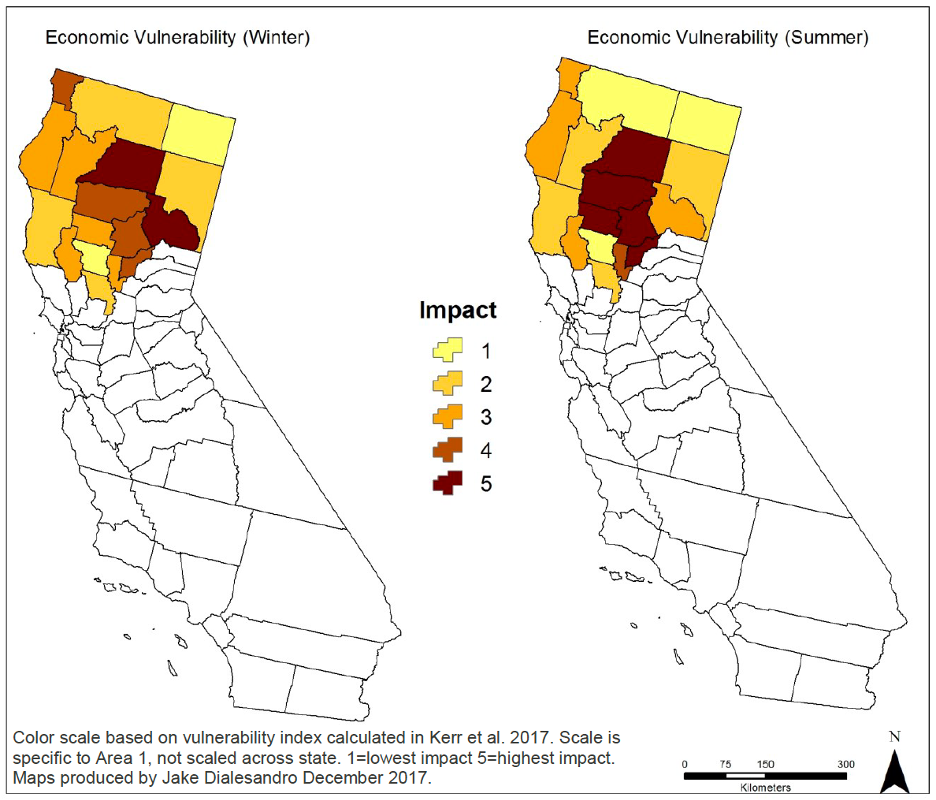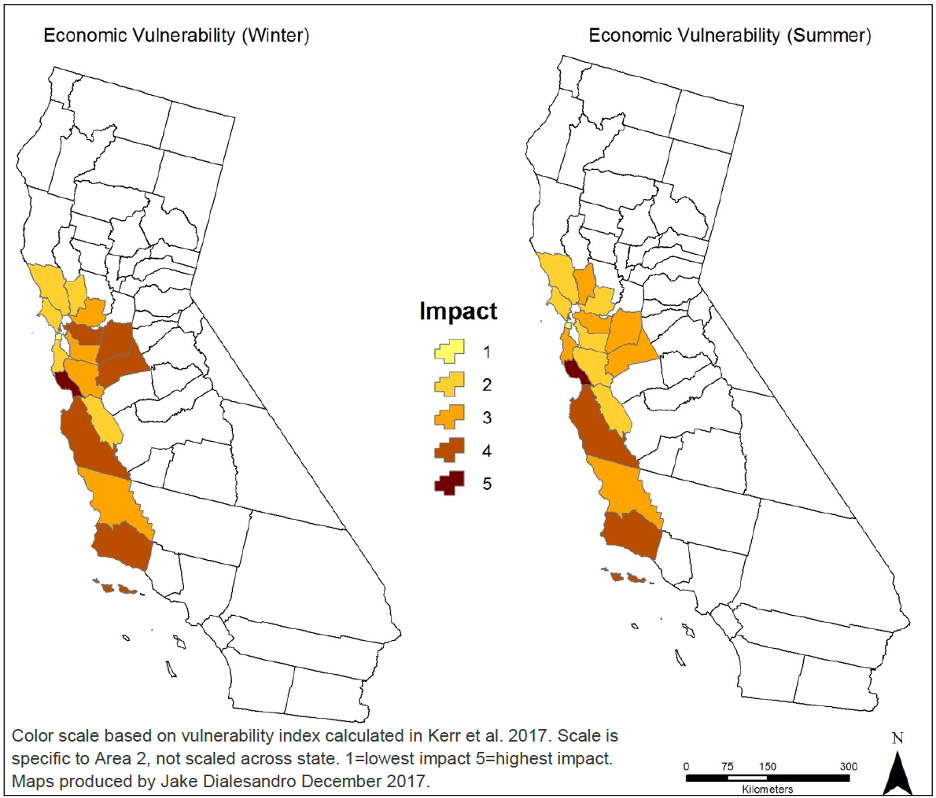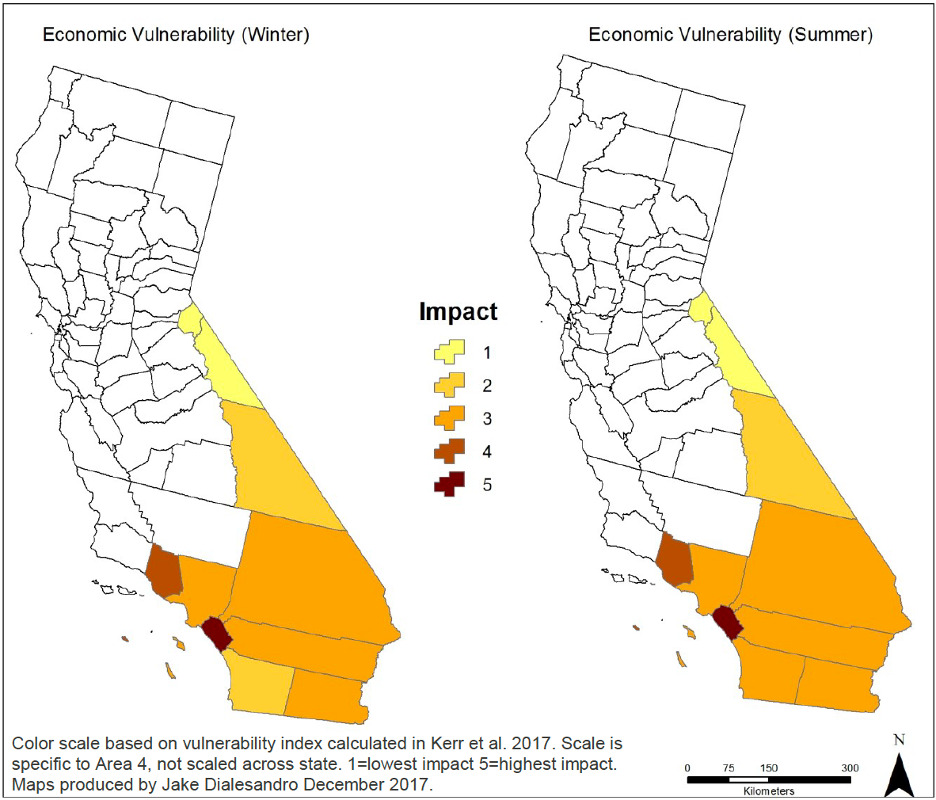Climate change impacts to California’s agricultural sector will vary by crop and growing region. Providing crop- and location-specific recommendations for adapting to future conditions and mitigating crop loss is critical to reducing economic impacts and maintaining food security at a local, state, and national level. Research has identified vulnerabilities to California’s agricultural economy at the county level based on county crop production, acreage, and market value, paired with projected changes in climate. For example, California crops with high chill requirements and a low tolerance for heat exposure may be particularly at risk. When we examine the vulnerability of California specialty crops at the NRCS Area scale, we can identify crops most sensitive to increased temperatures and subsequently the regional susceptibility to agriculture-sector economic declines. Understanding where economic impacts are most likely, and the crop systems driving those potential economic risks, allows us to focus on adaptation actions that could most benefit the agricultural economies of each California region. The information here highlights the crops and counties most vulnerable to economic losses across the state, and provides growers, farm advisors, and extension specialists with suggested strategies for adapting to climate change and mitigating economic losses.
AREA 1

California's Area 1 covers Northern California, including the Sacramento Valley, where cool-tolerant and high-chill crops are grown. In this area, the top five "crops to watch" include almonds, walnuts, tomatoes, stone fruit, and wine grapes. These crops are sensitive to warming temperatures, are high value, and are planted in significant acreage within the region. Click the drop-downs to read more about the vulnerabilities of and adaptation strategies for each of these crops, or see the fact sheet on Area 1 here.
-
Climate-related challenges for almond production may drive declines in the agricultural economies of Glenn, Sutter, Tehama, and Yolo Counties. Almonds’ summer heat vulnerability, chill-portion requirements, dependency on bee pollination, and increased pest pressure with warmer weather coupled with their high value make them an economic driving force. Adaptation strategies include frost avoidance through heat reflection products to delay bloom, changes in harvest timeframe to avoid pest pressures, and deficit irrigation strategies to adapt to statewide drought conditions. Planting natural pollinator habitat could alleviate honey bee population decline and breeding programs to develop low-chill, self-pollinating, insect resistant, and earlier yielding varieties will be essential to the longevity of almond orchards in California.
-
Tomatoes experience yield reductions when conditions fall outside of their optimal temperature range. For most varieties, daytime optimal temperatures range from 75-95°F, and nighttime optimal temperatures from 55-70°F. In some cooler counties tomatoes could benefit from increased temperatures, but in Colusa, Sutter, and Yolo, tomatoes are economically vulnerable due to projected warming. On farm management strategies for these areas are limited to heat tolerant variety selection.
-
Walnuts are extremely vulnerable to the projected increases in winter temperatures because of their high chill requirements. Walnuts are also moderately vulnerable to extreme summer heat. The counties likely to experience economic losses due to projected warming are Butte, Glenn, Lake, Sutter, Tehama, Yolo, and Yuba. To reduce the effects of summer heat waves, irrigation can be carefully monitored to avoid water stress and trees can be treated with sunburn spray. There are no government-approved products available for combating warmer winters, but producers can advocate for more breeding of heat-tolerant and low chill varieties.
-
Stone fruits -- which include apricots, cherries, peaches, plums, prunes, and nectarines -- are sensitive to increases in summer temperatures, extreme heat events, and reductions in winter chill. The counties most vulnerable to economic loss from climate change impacts to stone fruit are Butte, Sutter, Tehama, and Yolo. As spring and summer temperatures rise, the trees are vulnerable to decreased fruit set, decreased fruit size, and sunburn. Early fruit thinning to increase remaining fruit size and irrigation to avoid water stress can mitigate temperature effects. Producer advocacy for increases in low-chill research and breeding could benefit new cultivar options.
-
The economies of Lake, Mendocino, and Yolo counties may be impacted by climate change impacts to wine grapes. Wine grape yield is moderately sensitive, and grape flavor is highly sensitive to temperature increases. On-farm techniques that may help avoid economic loss include transitioning to varieties with greater heat tolerance, canopy misting, irrigation tactics, trellising type, canopy management, partial shading, reflective material spray, and taller vine training height. Changing varieties may not be feasible due to market demand.
AREA 2

Area 2 covers the Bay Area, the Sacramento-San Joaquin Delta, and the well-known wine region of the Central Coast. Area 2 also includes the Salinas Valley, which is known for growing strawberries, lettuce, and tomatoes. In this area, the top "crops to watch" include almonds and walnuts, strawberries, cole crops, lettuce, and wine grapes. These crops are sensitive to warming temperatures, are high value, and are planted in significant acreage within the region. Click the drop-downs to read more about the vulnerabilities of and adaptation strategies for each of these crops, or see the fact sheet on Area 2 here.
-
San Joaquin and Stanislaus counties are home to large acreage almond and walnut orchards. Almonds are susceptible to increased pest pressures and their dependence on bee pollination, which may see challenges due to shifting phenology under warmer spring conditions. Walnuts will primarily be challenged by warmer winters due to their high chill requirements. Walnuts are also moderately vulnerable to extreme summer heat. For almonds, matching bloom to bee phenology may require the application of products to delay bloom, and breeding programs to develop self-pollinating, insect resistant, and earlier yielding varieties may alleviate stress due to honey bee population decline, pest pressures, and water challenges. For both walnuts and almonds, deficit irrigation strategies may be useful to adapt to drought conditions, while sunburn spray may be another option for mitigating the effects of summer heatwaves. While there are no well-tested and approved means for improving chill hours for walnut producers, growers can advocate for the development of lower-chill varieties to combat warming winters.
-
Cole crops include cruciferous vegetables like broccoli and cauliflower, as well as field vegetables like cabbage. Cole crops are widely grown in Monterey and Santa Barbara counties, where projected increases spring and summer temperatures may stress or damage cole crop production. Cole crops have narrow optimal temperature ranges, preferring temperatures below 68°F. Temperatures above 80°C can cause bolting in cabbage and cause stunted growth and discoloration in cauliflower. Where possible, adapting planting and harvest dates to avoid heat stress is a potential adaptive action for the near-term. In the longer term, a northward or up-hill shift in where cole crops are planted could provide new opportunities for some growers while maintaining cole crop production within the state. As with other crops, breeding for heat tolerance may also provide an adaptive edge.
-
Monterey, Santa Barbara, and Santa Cruz counties are home to significant acreage of strawberry fields. Strawberries are highly sensitive to projected warming and consequently, these counties’ agricultural economies may be vulnerable should climate change impact strawberry production. Warmer temperatures can shorten strawberry growth cycles, promote pest and disease pressures, and lower the success of pollination. Adaptive practices include using ventilated protective structures to provide shade, and using irrigation to provide evaporative cooling and mitigate plant heat stress. In the long run, strawberry production may benefit from a geographic move to cooler parts of the state.
-
Lettuce is quite sensitive to warming temperatures, with ideal growing temperatures between 73°F (daytime) and 45°F (nighttime). Warmer spring and summer temperatures can cause bolting, while temperatures above 90°F cause bitterness. The most vulnerable counties to economic losses from lettuce damage are Monterey, Santa Barbara, and Santa Cruz. Planting and harvesting earlier may avoid heat stress. Changing to heat tolerant and bolt-resistant varieties may also mitigate climate risks.
-
Climate change-induced damages to wine grapes could impact the agricultural economies of Monterey, Napa, San Joaquin, San Luis Obispo, and Sonoma counties. These counties are at risk of warming winter temperatures, and may also experience increased frequency of heatwaves during summer that could stress some varieties of grapes. On-farm techniques that may help avoid losses due to heat damage include transitioning to varieties with greater heat tolerance, canopy misting, irrigation tactics, trellising type, canopy management, partial shading, reflective material spray, and taller vine training height. Changing varieties may not be feasible due to market demand.
AREA 3

California's Area 3 covers the San Joaquin Valley and the western Sierra Nevada and Foothills. In this area, the top "crops to watch" include almonds, pistachios, tomatoes, stone fruit, and wine & table grapes. These crops are sensitive to warming temperatures, are high value, and are planted in significant acreage within the region. Click the drop-downs to read more about the vulnerabilities of and adaptation strategies for each of these crops, or see the fact sheet on Area 3 here.
-
Climate-related challenges for almond production may drive declines in the agricultural economies of Fresno, Kern, Kings, Madera, Merced, and Tulare counties. Almonds’ summer heat vulnerability, chill-portion requirements, dependency on bee pollination, and increased pest pressure with warmer weather coupled with their high value make them an economic driving force. In the San Joaquin Valley in particular, warmer summer temperatures and more extreme heat will likely increase water demand, making water stress an especially acute challenge. Similarly, in the warmest regions of Area 3, warmer winter temperatures may mean insufficient chill accumulation. Deficit irrigation strategies to adapt to increased water demand may be possible during certain development phases, while lower chill varieties may offer an option for continued almond production in regions with warmer winters. Planting natural pollinator habitat could alleviate honey bee population decline and breeding programs to develop low-chill, self-pollinating, and insect resistant varieties will also be beneficial for almond production in California.
-
Tomatoes experience yield reductions when conditions fall outside of their optimal temperature range. For most varieties, daytime optimal temperatures range from 75-95°F, and nighttime optimal temperatures from 55-70°F. In some cooler counties tomatoes could benefit from increased temperatures, but in Fresno, Kern, Kings, and Merced counties, tomatoes are economically vulnerable due to projected warming. While shade and cooling practices could provide some relief from one-off, moderate heat events, projected temperatures and heat extreme frequency will push many locations beyond the optimal range for tomato production. In this case, on farm management strategies for these areas are largely limited to heat tolerant variety selection, and in some locations transitioning to new crops may be a better option.
-
Fresno, Kern, Kings, Madera, and Tulare counties are home to large acreage pistachio plantings, which are vulnerable to the projected increases in winter temperatures. Pistachios have high chill requirements that may not be satisfied by the warmer winter temperatures expected over the coming decades. Transitioning to lower-chill varieties (e.g. Mateur pistachio) may provide some adaptive capacity, and growers can advocate for the development of new low-chill varieties for future warming. Pistachios are also moderately vulnerable to pest pressures, which are likely to increase under warming conditions. Managing for uniform maturity timing could help to mitigate any increases in summer pest pressure.
-
Stone fruits generally are sensitive to increases in summer temperatures, extreme heat events, and reductions in winter chill. In Fresno and Tulare counties, stone fruit will experience all of these challenges, as summer and winter temperatures warm, and heat extremes become more frequent and intense. Reduced chill accumulation can impact fruit set and fruit development (e.g. fruit size), while warmer summer temperatures can cause sunburn. Early fruit thinning to increase remaining fruit size after poor fruit set, and irrigation to avoid water stress can mitigate temperature effects. However, while some water stress can increase sugar content (and therefore improve flavor), extreme heat and extreme evaporative demand may make sufficient irrigation difficult resulting in fruit damage. Producer advocacy for increases in low-chill research and breeding could benefit new cultivar options.
-
Fresno, Kern, Madera, Sacramento, Merced, and Tulare counties all produce wine grapes, which are sensitive to temperature increases from both a yield and flavor or berry quality perspective. While much can be done in the winery to combat less-than-ideal berry chemistry, reduced yield and quality of a high-value commodity like wine grapes has the capacity to impact the agricultural economies of these counties. Fresno, Kern, and Tulare counties are also at risk of damages to their table grape production due to table grape vulnerabilities to increasing summer temperatures. On-farm techniques to mitigate heat damages include transitioning to varieties with greater heat tolerance, canopy misting, irrigation tactics, trellising type, canopy management, partial shading, reflective material spray, and taller vine training height. Because market demand drives the varieties planted, immediate changes in variety may not be an adaptation option, though producers and the broader industry may wish to consider, where possible, marketing with the goal of increasing demand for more heat-tolerant varieties over the long term.
AREA 4

Area 4 covers Southern California, including the the Coachella and Imperial Valleys, and the eastern Sierra. Area 4 also includes southern coastal counties known for avocado production. In this area, the top "crops to watch" include strawberries, lettuce, carrots, avocados, and table grapes. These crops are sensitive to warming temperatures, are high value, and are planted in significant acreage within the region. Click the drop-downs to read more about the vulnerabilities of and adaptation strategies for each of these crops, or see the fact sheet on Area 4 here.
-
The agricultural economies of Orange and Ventura counties may be vulnerable to declines in strawberry production because of the crop’s high value, acreage, and climate sensitivity. Warmer temperatures can shorten the strawberry growth cycle, promote pest and disease pressure, and reduce pollination. Using ventilated protective structures to provide shade and using irrigation as a cooling mechanism and to avoid crop water stress are currently the best on-farm methods for mitigating heat stress. In the coming years and decades, maintaining strawberry production may require moving production to cooler zones.
-
Carrot production in Kern and Imperial counties may be challenged by future climate conditions, particularly increased summer temperatures. While summer and winter temperature increases could impact carrot farming, the crop is most sensitive to summer maximum temperatures, with temperatures above 86°F negatively affecting flavor, and heat stress resulting in a loss of color. Poor flavor profiles and lack of color both result in decreased value. Secondary impacts include the increased disease and weed pressures expected with warmer conditions. Because of the exceptionally long growing-season in Kern and Imperial counties, adjusting planting dates may allow for carrot producers to avoid the most damaging heat.
-
More than 90% of US-grown avocados are grown in California. Production in San Diego and Ventura counties may be at risk of damages from projected increases in summer temperatures, making the agricultural economies of these counties vulnerable given the high value of the crop. Avocados are extremely sensitive to drought conditions and salinity, both of which may be exacerbated with higher temperatures, and the subsequent increased evaporative demand. In the long-term, breeding programs could provide some adaptive opportunities, while in the near-term, the lower chance of freezes and lack of significant pest pressure may benefit avocado production if water-related challenges can be minimized.
-
Lettuce is quite sensitive to warming temperatures, with ideal growing temperatures between 73°F (daytime) and 45°F (nighttime). Warmer spring and summer temperatures can cause bolting, while temperatures above 90°F cause bitterness. The most vulnerable counties to economic losses from lettuce damage are Imperial, Riverside, and Ventura. Planting and harvesting earlier may avoid heat stress. Changing to heat tolerant and bolt-resistant varieties may also mitigate climate risks.
-
Temperature increases can impact the cosmetic appearance of table grapes, which could impact production in Kern County. On-farm adaptation includes transitioning to varieties with greater heat tolerance, canopy misting, irrigation tactics, trellising type, canopy management, partial shading, reflective material spray, and taller vine training height.

